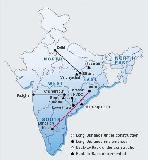
The Power Grid of the country is very important to transfer power from the surplus regions to the deficit ones and to manage the peak deficit problems. A National Power Grid was completed by linking all the five Regions-North, South, East, West and North East. It is the largest single system in the world both in terms of grid size and a system capacity of around 200000 MW.
The National Power Grids system was completed with commissioning of 765kV S/c Raichur – Sholapur line on December 31, 2013 ahead of the targeted time with the leadership of the Power Grid Corporation of India. This 208 circuit kilometer (ckm) connected the southern region with the rest of India with a capacity of 4200 MW. Southern region is a power deficit region and the new transmission link is expected to solve most of its power deficit problems. As on March 2016, the capacity transfer of the National Power Grid is 28000 MW and the garget is to enhance it to 65550 MW by the end of the twelfth plan.
Completion of the power grid has enabled the country to better manage power problems through efficient transmission. The objective of ‘One Nation- One Grid-One Frequency’ is necessary to get full utilization of the nearly 290 GW capacity installed in the country. Besides the National Power Grid, transmission lines within states are also on completion and modernization mode.
The Kudankulam nuclear power plant with a 2000 MW capacity for its first two units is linked with the Power Grid. Power from Unit-I is currently supplied to Tamil Nadu (562.5 Mw), Karnataka (221 Mw), Kerala (133 Mw), Andhra Pradesh (50 Mw) and Puducherry (33.5 Mw), and the share of power allocation from unit-II will be the same, except for Telangana replacing Andhra.
Another power sector unification factor is the Indian Energy Exchange that provides a spot market for power across the country.
*********









